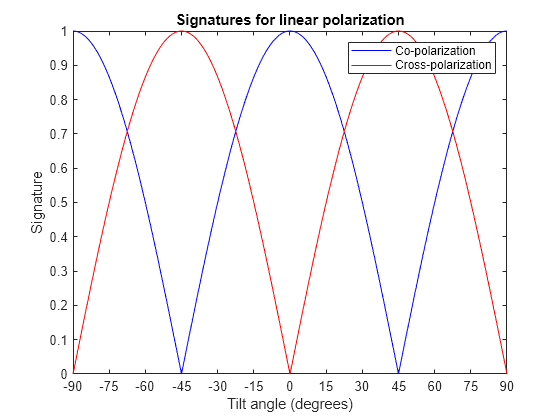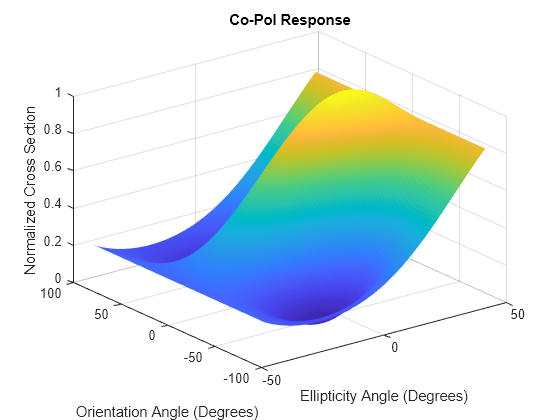polsignature
Copolarization and cross-polarization signatures
Syntax
Description
resp = polsignature(rcsmat)resp (in square meters), determined
from the scattering cross section matrix, rcsmat of
an object. The signature is a function of the transmitting antenna
polarization, specified by the ellipticity angle and the tilt angle
of the polarization ellipse. In this syntax case, the ellipticity
angle takes the values [-45:45] and the tilt angle
takes the values [-90:90]. The output resp is
a 181-by-91 matrix whose elements correspond to the signature at each
ellipticity angle-tilt angle pair.
resp = polsignature(rcsmat,type)'c'|'x',
where 'c' creates the copolarization signature
and 'x' creates the cross-polarization (cross-pol)
signature. The default value of this parameter is 'c'.
The output resp is a 181-by-91 matrix whose elements
correspond to the signature at each ellipticity angle-tilt angle pair.
This syntax can use the input arguments in the previous syntax.
resp = polsignature(rcsmat,type,epsilon)epsilon must
lie between –45° and 45°. The argument resp is
a 181-by-M matrix whose elements correspond to
the signature at each ellipticity angle-tilt angle pair. This syntax
can use any of the input arguments in the previous syntaxes.
resp = polsignature(rcsmat,type,epsilon,tau)tau must be between –90°
and 90°. The signature, resp, is represented
as a function of the transmitting antenna polarization. The transmitting
antenna polarization is characterized by the ellipticity angle, epsilon,
and the tilt angle, tau. The argument resp is
a N-by-M matrix whose elements
correspond to the signature at each ellipticity angle-tilt angle pair.
This syntax can use any of the input arguments in the previous syntaxes.
polsignature(___) plots a three
dimensional surface using any of the syntax forms specified above.
Examples
Input Arguments
Output Arguments
More About
References
[1] Mott, H. Antennas for Radar and Communications.John Wiley & Sons, 1992.
[2] Fawwaz, U. and C. Elachi. Radar Polarimetry for Geoscience Applications. Artech House, 1990.
[3] Lee, J. and E. Pottier. Polarimetric Radar Imaging: From Basics to Applications. CRC Press, 2009.
Extended Capabilities
Version History
Introduced in R2013a



